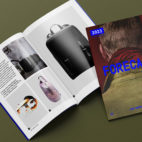Zippers, neoprene & nylon
Zippers, neoprene & nylon.
3 questions got asked, 3 answers were provided. A little insightful education into the world of carry. Do you know what neoprene is good for? Do you know why zippers catch? Read on for a little Carryology 101…
1/ What is the advantage/disadvantage of using neoprene (like wetsuit material) on a bag? How is it for moisture/rain?
If high grade neoprene without cheap fillers is used, it can be baked to stretch 400%, but that gets expensive. Most neoprene used in bags is cheap (watered down with fillers), and stretches around 50%. It’s nice because it is thicker and more structured than regular elastanes, so sits flatter and feels more substantial. The downside is that the nylon jersey that is laminated to the neoprene for strength (unlaminated neo can ‘chunk’) and can get smelly if used in moist environments (it’s a knit, so it holds water and turns smelly). Very few brands use neoprene well in bags (other than as stretch gussets on the inside of sandwich travel bags). Aesthetically, if you want a nice sheen to the neoprene you should check in with the surf companies, they have it on lock.
2/ What is the main type of nylon used in most bags/backpacks? Or are there many types? I hear names like Codura and Ripstop and don’t know the difference?
Bags are most commonly made from woven Polyester or Nylon (PolyAmide). Polyester is cheaper and more a little more matte in appearance (most school bags and cheaper action sports brands bags are Polyester). Nylon is stronger, and has more of a shine to it. The really thin fabrics are nylons, most of the tech outdoor bags are nylon, and that thick weave ballistic used in travel is a nylon. Ripstop means there’s a check pattern woven through the fabric that you can see (usually 5mm squares or so). If a tear starts, it’s meant to hit the next woven line and stop tearing. Ripstop makes the most sense in really lightweight outdoor packs where a tear is more likely to happen. Cordura is just a brand name, who make both Polyesters and Nylons (yeah, confusing). The reason Cordura is talked about is that their fabrics are made from pretty high grade raw materials, and their backings are high grade, so the overall quality is high.
3/ Why are some zippers non-snag and others snag? What exactly is added to zippers to make it not get stuck? Is it the lining under the zipper?
Loads of things can affect zippers. The biggest is how quality the zip brand is. Zip teeth are tiny, and so if your manufacturing isn’t spot on, the ‘cogs don’t mesh’ so to speak. But then if a zip is sown in with uneven tension by a shit sower, it can get pulled on badly and not work well. Sometimes designers ask zips to bend sideways (which they don’t like to do), sometimes linings jam, sometimes the raw plastics they used are shit and deform too easily. There’s LOTS to go wrong in zippers.
NB: We don’t claim for these answers to be a 100% correct but form the experience we’ve had with the above topics, these are the insights we’ve gained. If you have anything to add, please let us know in the comments! Additionally, if you have any other questions you’d like us too have a go at answering, hit us up below. Thanks!





 Carry Awards
Carry Awards Insights
Insights Liking
Liking Projects
Projects Interviews
Interviews













